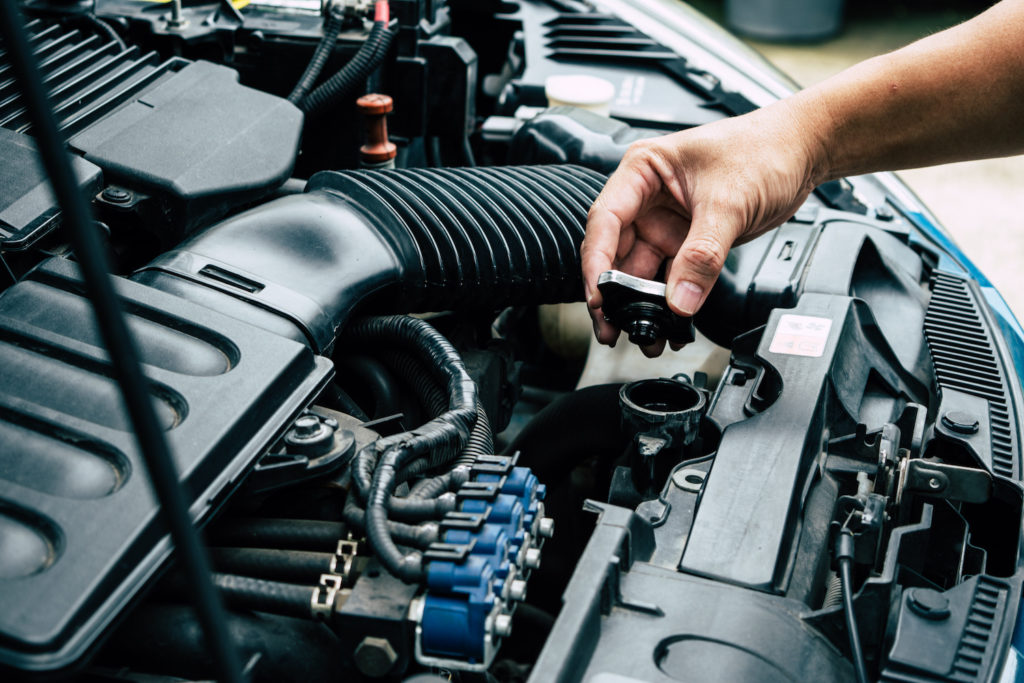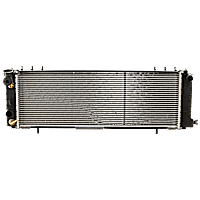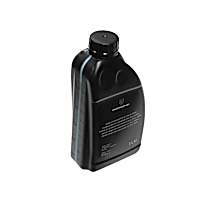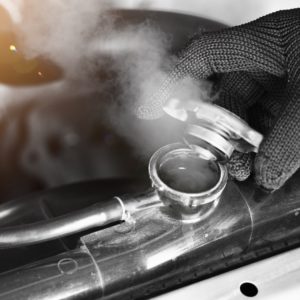Radiator fluid, also known as engine coolant or antifreeze, was first used in military vehicles during World War I. Ethylene glycol was initially used as an alternative to glycerol to prevent radiators from freezing overnight. By 1923, it became common for automakers to use ethylene oxide-based coolant in engine manufacturing. It took more than a decade before traditional, inorganic, green antifreeze was introduced.
By the late 90s, this was phased out and replaced by organic additive technology (OAT) and hybrid organic additive technology (HOAT) coolants—the most common types you’ll see today.
These formulas come in a variety of radiator fluid colors, including orange, red, and gold. In this article, we’ll discuss how you can distinguish between the different colors and types of radiator fluid.
What is Radiator Fluid?
Radiator fluid (coolant) is basically a mixture of antifreeze (ethylene glycol), water, and corrosion inhibitors. These corrosion inhibitors can either be organic, inorganic, or a hybrid mixture. They may also be referred to as an additive package.
Although these inhibitors are only a very small portion of the coolant mixture, they are what define the coolant type.
This coolant acts as a heat transfer medium to remove heat from the engine, thereby preventing overheating. The mixture also keeps the engine block from freezing in the winter.
Aside from aiding in thermal management, radiator fluid also protects your engine from corrosion and maintains the cooling system’s efficiency by preventing the formation of rust, cavitation, scale, and foaming.
What Color is Radiator Fluid?
Radiator fluid comes in a variety of colors. You’ll find dealerships and automotive shops that carry bottles of pink, red, purple, green, orange, blue, and yellow coolant. But what most people don’t know is that they all start out as a colorless liquid that is later dyed by manufacturers.
Unfortunately, there is no standardized way to determine the type of coolant based on color alone.
To make sure that you have the right kind for your car, always read the description on the bottle and check it against your vehicle owner’s manual.
What’s Considered a Bad Radiator Fluid Color?
Old radiator fluid can turn to a brownish color and appear more opaque than translucent. In some cases, bad radiator fluid can also turn into sludge.
3 Types of Coolants for Your Engine
There are three main types of radiator fluid that can be used in your car’s engine: IAT, OAT, and HOAT.
Inorganic Acid/Additive Technology or IAT Coolant
IAT coolant is the most common type of radiator fluid that automakers have used for over 70 years. It is made up of an ethylene glycol base combined with silicate and phosphate additives.
Phosphates protect iron engine blocks from rust, while silicates protect damaged surfaces on the aluminum cylinder head from getting worse.
GM stopped using this green-colored coolant in 1994, while Ford and Chrysler switched to a different type in 2001. One of the main reasons for the switch is the change in the materials used in building engines. Older engines were usually cast iron, while today’s engines are typically made of aluminum.
At the same time, inorganic additives have a shorter service life and break down sooner than organic additives.
Organic Acid/Additive Technology or OAT coolant
The OAT coolant is a type of radiator fluid that contains organic inhibitors. This type of radiator fluid was initially dyed yellow or orange to distinguish it from the green IAT coolants.

Today, you’ll find OAT coolants in other colors like blue and dark green. It was initially advertised as a “permanent” antifreeze, but in reality, it still needs to be changed according to the manufacturer’s recommended maintenance schedule.
Hybrid Organic Acid/Additive Technology or HOAT coolant
HOAT coolant contains a hybrid mixture of inorganic and organic additives. The combination provides a longer service life compared to OAT coolants, while also offering greater compatibility.
It comes in different colors such as green, red, pink, blue, or orange. Pink and red-colored HOAT coolants are designed for alloy engines with G12 specifications, while the blue-colored variant is used in engines with G11 ratings.
How Often Should You Change Your Radiator Fluid?
Different types of engine coolant require changing at varying intervals. Some general guidelines are listed below. Consult your owner’s manual to determine the actual service interval for your vehicle.
- IAT coolant must be changed every 24,000 miles or every two years
- OAT coolant must be changed every 150,000 miles or every five years
- HOAT coolant must be changed every 150,000 miles or every five years
Can You Mix Different Types of Engine Coolant?
No—never mix different types of coolant. This will result in a gel-type substance that will clog and overheat the cooling system. Messing with the formulation of your radiator fluid can result in costly and permanent damage to your cooling system and engine.
At the same time, swapping IAT for OAT or HOAT (and vice versa) can reduce the coolant’s protective properties inside the engine.
Your safest bet is to choose the same type of fluid that the car manufacturer used in the engine when it rolled out of the factory. However, remember that having the same color doesn’t mean it’s the same type of coolant.
Also, keep in mind that coolant needs to be mixed with water. Some products come pre-mixed, while others come “full strength” and must be mixed with water. Be sure to check the instructions on the bottle before topping up your coolant reservoir.
Here’s a pro tip: you may ask your dealership for the type of coolant used for your specific make and model. Once you’ve gotten your radiator fluid changed, remember to write down the type of radiator fluid you last used. This way, you can easily pick up the same bottle the next time you need to top it off.
What Type of Radiator Fluid Do I Need?
Most vehicles work fine with a glycol-based coolant. However, it’s still a good idea to consult the owner’s manual to know the best radiator fluid for your vehicle.
Can You Use Water as Fluid for the Radiator?
Yes, but only for emergencies. Using water instead of radiator fluid won’t necessarily harm your vehicle.
However, water does freeze at 0॰, which can be dangerous under extreme weather conditions. Your engine can develop cracks and warps if water is left in the cooling system under freezing temperatures.
Water in the cooling system can also be dangerous under hot temperatures.
The engine can reach an operating temperature of above 100॰F and exceed the boiling point of water. Once this happens, the water will only evaporate without dissipating heat from the engine.
Putting tap water inside the cooling system can also increase the risk of corrosion in certain components.
Is it Safe to Drive with a Radiator Fluid Leak?
Driving with a radiator fluid leak can lead to a low coolant level and engine overheating. The end result is often extensive engine damage, and a massive repair bill.
Low radiator fluid levels will also shorten the life cycle of rubber and metal parts in your engine cooling system.
Coolant leaks are one of the most common symptoms of a bad radiator, so you’re going to want to address this problem right away. In some cases it should be fixable, but you may even end up needing a replacement radiator.

How to Check Radiator Fluid Levels
Checking your car’s coolant levels is simple and should be done at every oil change. Follow the steps below to find out if you need to top off your vehicle’s radiator fluid.
- Turn off your engine and let it cool. For your safety, do not attempt to check your coolant levels while your engine is hot. The cooling system is under extreme pressure when the cap is hot and can burst off, causing severe personal injury.
- Remove the pressure cap from the radiator or coolant reservoir (if there’s no radiator cap).
- The coolant level should reach the bottom of the pressure cap seat of the radiator or the fill line on the side of the reservoir.
If the coolant is low, there’s a leak somewhere. Have a professional mechanic diagnose the problem immediately to avoid overheating. Do not continue driving a vehicle with a low coolant level—this may result in severe engine damage.
Likewise, if the coolant is milky or oil-contaminated, have a professional check it out right away, as those symptoms often indicate major problems.
Products Mentioned in this Guide
Any information provided on this Website is for informational purposes only and is not intended to replace consultation with a professional mechanic. The accuracy and timeliness of the information may change from the time of publication.


 Radiator
Radiator
 Coolant/Antifreeze
Coolant/Antifreeze




























Wow. An excellent article about Radiator Fluid by Mitchell Dyche. He really knows what he is talking about.
I thoroughly enjoyed reading (and re-reading) this article. Mitchell explained more about different types of antifreeze (IAT, OAT & HOAT) than I even knew existed. It’s like a Classroom-in-an-Article.
Thank you for this information.